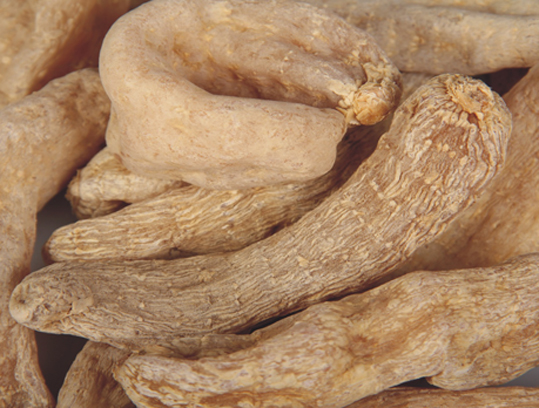Gastrodia elata, also known as Tian Ma in Pinyin, can be traditionally used as a Chinese herb for the treatment of headaches, dizziness, numbness, convulsions in children, Epilepsy, tetanus, hemiplegia, Neurasthenia, angioneurotic headache, cerebral arteriosclerosis, Senile Dementia, sudden deafness, central retinitis, cervical spondylosis, Meniere's syndrome, and so on. The main medicinal part is its root. Because of the huge demand clinically, the overexploitation has led to the decline of gastrodia populations in the wild. For that reason, it has been rated as a vulnerable species by the International Union for Conservation of Nature (IUCN) and included in the Appendix II of The Convention on International Trade in Endangered Species of Wild Fauna and Flora (CITES). In the past the supply of gastrodia tuber was mainly from the wild resource. But things have changed since it was successfully cultivated in the 1970s and home-grown species gradually become the main source of goods.
Medicinally it mainly refers to the dried tubers of Gastrodia elata blume, which is an herb in orchid family, Orchidaceae. This species have 5 variants, including Gastrodia elataf.elata, Gastrodia elataf.glaucaS.Chow (1983), Gastrodia elataf.viridis (Makino) Makino (1940), Gastrodia elataf.flavidaS.Chow (1993), and Gastrodia elataf.albaS.Chow (1983). These variations were mainly determined by Professor Zhou Xuan, the China's most famous Tianma expert. Hence, other common names of this herb include Gastrodia Root, Rhizoma Castrodiae, Ming Tian Ma, Tianma, Rhizoma Gastrodiae Elatae, gastrodia rhizome, and the like. In China it is mainly produced in provinces of Sichuan, Yunnan, and Guizhou. Based on the different harvesting time, there are two types of gastrodia herbs – Dong Ma (winter) and Chun Ma (spring). In general the one dug up in winter when the stem perishes is considered better in medicinal properties than the one dug in spring when they germinate. And the following steps are to clean, steam thoroughly, and dry in the air at low temperatures. Medicinally it is used moistened or steamed and sliced. By the way, the plant’s stems, leaves, and fruits are also used for medicinal purposes.

Gastrodia Elata
Gastrodia benefits
The medicinal uses of gastrodia elata are characterized by calming liver wind agitation by suppressing hyperactive liver and calming hyperactivity of liver-yang by tranquilizing liver and yang. However, other herbs like Cat's Claw (Gou Teng) and Antelope Horns (Ling Yang Jiao) are also capable of what it does. So, what are the distinct health benefits of gastrodia? Actually, Cat's Claw is of cool, light, and penetrating nature, which makes more sense in treating mild convulsions and fever in children since it is good at clearing heat for calming endogenous wind; Antelope Horns have a more powerful heat-clearing properties since it is of cold nature. In addition to be used in treating extreme heat causing wind, it cures also coma due to high fever, spots caused by heat toxicity, etc. since it is able to clear away the heart-fire and detoxify; gastrodia is of sweet, neutral, and moist nature. It has less ability on clearing heat than Cat's Claw and Antelope Horns. Its strength is the versatility of any types of up-stirring of the liver and epileptic seizures, regardless of the patterns are of cold, heat, deficiency or excess nature. What’s more, it can relieve mind to bring headache relief.
Now it is time to talk about luminous fungi called Armillaria mellea Fr., which is the nutrient source of gastrodia seeds and tubers. Studies have shown that the solid culture of Armillaria has similar pharmacological effects and clinical efficacy of gastrodia. For the reason, now the medicinal preparations of Armillaria mellea Fr. are mostly replaced Tianma to treat dizziness, Headache, Insomnia, hemiplegia, numbness, and so on.

![Diseases, Symptoms, tcm, [tcmwindow.com]](/uploadFile/adImg/2015/11/11/f5cbfcc0-4df5-4646-9b9a-f316651a0199.jpg)





